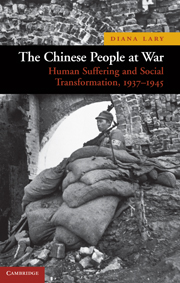Book contents
- Frontmatter
- Contents
- List of Illustrations
- List of Maps
- Preface
- Introduction: The Human Cost of War
- 1 The High Tide of War: July–December 1937
- 2 Defeat and Retreat: 1938
- 3 Stalemate and Transformation: 1939–1941
- 4 Grim Years: 1942–1944
- 5 Turning Points: 1944–1945
- 6 The Immediate Aftermath of the War: 1945–1946
- 7 The Legacy of the War
- Final Words
- Glossary
- Index
- References
4 - Grim Years: 1942–1944
Published online by Cambridge University Press: 05 June 2012
- Frontmatter
- Contents
- List of Illustrations
- List of Maps
- Preface
- Introduction: The Human Cost of War
- 1 The High Tide of War: July–December 1937
- 2 Defeat and Retreat: 1938
- 3 Stalemate and Transformation: 1939–1941
- 4 Grim Years: 1942–1944
- 5 Turning Points: 1944–1945
- 6 The Immediate Aftermath of the War: 1945–1946
- 7 The Legacy of the War
- Final Words
- Glossary
- Index
- References
Summary
Events
At the end of 1941, Japan attacked the United States and within the next few weeks took Hong Kong, the Philippines, Malaya, Singapore, and Indonesia. The United States entered World War II and joined the Allies in an all-out war with the Axis powers (Germany, Italy, and Japan). The Japanese attack on Pearl Harbor was a tremendous success, but as Admiral Yamamoto, commander-in-chief of the Japanese Navy recognised at the time, it was also the beginning of the end for the Japanese imperialist enterprise. American outrage brought the country's full might against Japan. This meant active involvement in China.
The two years that followed the start of the Pacific War were marked in China by a combination of optimism and pessimism. On the optimistic side, China now had determined foreign allies, the United States, Britain, Australia, Canada, and the USSR, who would take the war to the enemy and increase the likelihood of Japan's defeat. On the pessimistic side, the political unity that had been so important at the beginning of the war was gone, inflation was gaining ground, and morale was seeping away. A new wave of refugees fled into China from Hong Kong.
During 1942 and 1943, there was little fighting in China itself. The Japanese armies were fully engaged in the occupation of Southeast Asia and in planning their attack on their ultimate goal, India. To deny them this prize, Chinese troops fought beyond China's borders in the Burma campaigns.
- Type
- Chapter
- Information
- The Chinese People at WarHuman Suffering and Social Transformation, 1937–1945, pp. 112 - 145Publisher: Cambridge University PressPrint publication year: 2010



